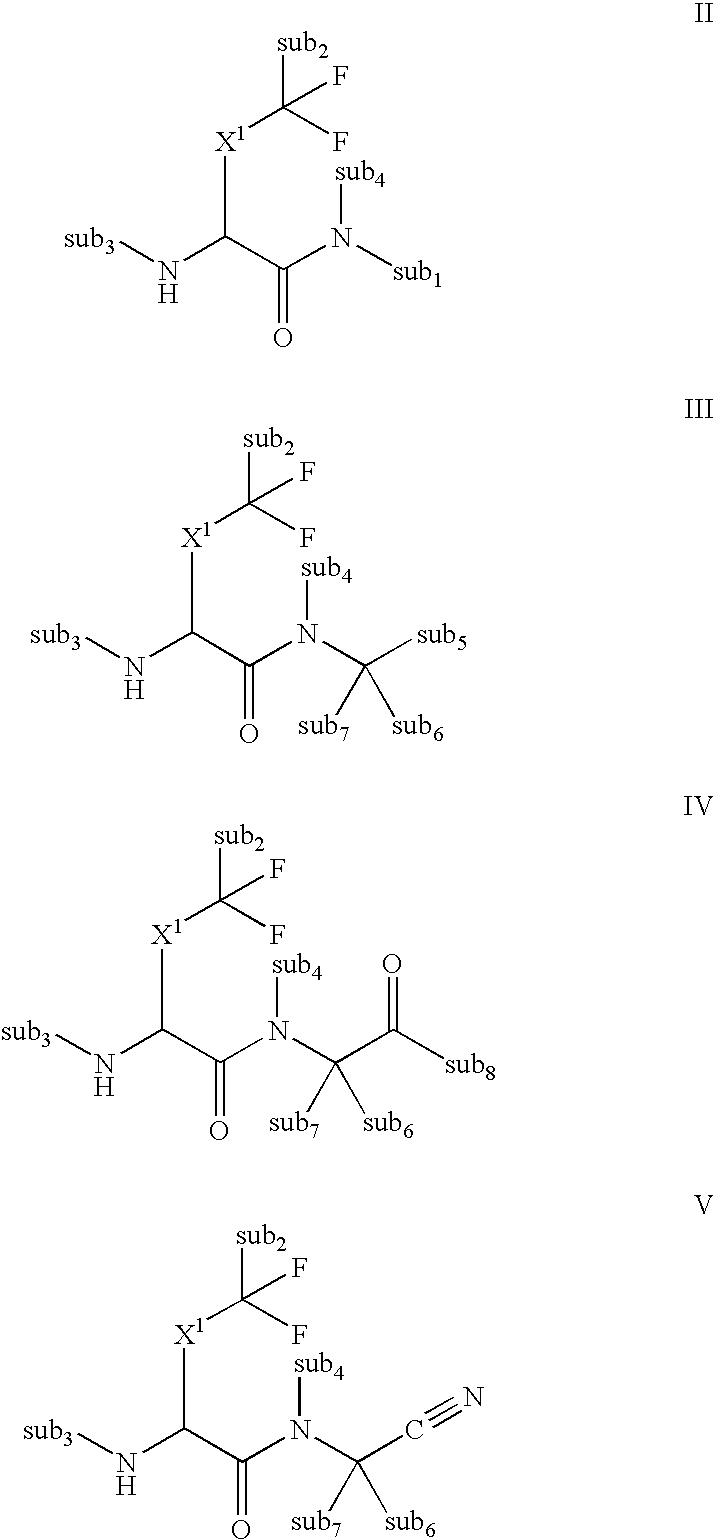Compounds and compositions as cathepsin inhibitors
a technology of compound and composition, which is applied in the field of new difluoro derivatives, can solve problems such as pathological consequences
- Summary
- Abstract
- Description
- Claims
- Application Information
AI Technical Summary
Benefits of technology
Problems solved by technology
Method used
Image
Examples
example 1
Morpholine-4-carboxylic acid {(S)-1-[(S)-1-(3-cyclopropyl-1,2,4-oxadiazole-5-carbonyl)-propylcarbamoyl]-3,3-difluoro-hexyl}-amide
[0404]
[0405]To a mixture of (S)-4,4-difluoro-2-[(morpholine-4-carbonyl)-amino]-heptanoic acid (104 mg, 0.35 mmol), (S)-2-amino-1-(3-cyclopropyl-1,2,4-oxadiazol-5-yl)-butan-1-ol hydrochloride (86.7 mg, 0.37 mmol) and diisopropyl amine (219 mg, 0.42 mmol) in dry dichloromethane (5 mL) is added PyBOP (113 mg, 0.87 mmol). The mixture is stirred at room temperature for 16 hr and the evaporated in vacuum. The residue is diluted with ethyl acetate (25 mL) and washed with saturated NaHCO3 (30 mL), dilute HCl (30 mL), then saturated NaHCO3 (30 mL). The organic layer is dried over magnesium sulfate and concentrated in vacuum. The residue is purified over 12 g silica gel, eluting with ethyl acetate: heptane (2:1 then 1:0) to afford morpholine-4-carboxylic acid (1-{1-[(3-cyclopropyl-[1,2,4]oxadiazol-5-yl)-hydroxy-methyl]-propylcarbamoyl}-3,3-difluoro-hexyl)-amide (146...
example 2
Morpholine-4-carboxylic acid {(S)-1-[(S)-1-(5-cyclopropyl-1,3,4-oxadiazole-2-carbonyl)-propylcarbamoyl]-3,3-difluoro-hexyl}-amide
[0409]
[0410]PyBOP (171.73 mg, 0.33 mmol), diisopropylethylamine (0.0575 mL, 0.33 mmol) and (S)-2-amino-1-(5-cyclopropyl-1,3,4-oxadiazol-2-yl)-butan-1-ol; compound with trifluoro-acetic acid (0.30 mmol) are added to a solution of (S)-4,4-Difluoro-2-[(morpholine-4-carbonyl)-amino]-heptanoic acid (88.29 mg, 0.30 mmol) in dry methylene chloride (4 mL) and the reaction mixture is stirred overnight at room temperature. The reaction is quenched with aqueous sodium bicarbonate, extracted twice with methylene chloride, the organic extracts are dried over sodium sulfate and evaporated under reduced pressure. Column chromatography on silica eluting with a mixture of methylene chloride and ethyl acetate gives morpholine-4-carboxylic acid ((S)-1-{(S)-1-[(5-cyclopropyl-1,3,4-oxadiazol-2-yl)-hydroxy-methyl]-propylcarbamoyl-}3,3-difluoro-hexyl)-amide as a solid (87 mg). L...
example 3
Morpholine-4-carboxylic acid ((S)-3,3-difluoro-1-{(S)-1-[5-(4-trifluoromethoxy-phenyl)-1,3,4-oxadiazole-2-carbonyl]-propylcarbamoyl}-hexyl)-amide
[0414]
[0415]PyBOP (68.69 mg, 0.13 mmol), diisopropylethylamine (0.023 mL, 0.13 mmol) and (S)-2-Amino-1-[5-(4-trifluoromethoxy-phenyl)-1,3,4-oxadiazol-2-yl]-butan-1-ol (38.0 mg, 0.12 mmol) are added to a solution of (S)-4,4-Difluoro-2-[(morpholine-4-carbonyl)-amino]-heptanoic acid (34 mg, 0.12 mmol) in dry methylene chloride (4 mL) and the reaction mixture is stirred overnight at room temperature. The reaction is quenched with aqueous NaHCO3, extracted twice with methylene chloride, the organic extracts are dried over Na2SO4 and evaporated under reduced pressure. Column chromatography on silica eluting with a mixture of methylene chloride and ethyl acetate gives morpholine-4-carboxylic acid [(S)-3,3-difluoro-1-((S)-1-{hydroxy-[5-(4-trifluoromethoxy-phenyl)-1,3,4-oxadiazol-2-yl]-methyl}-propylcarbamoyl)-hexyl]-amide as a solid (61 mg). LC / MS ...
PUM
| Property | Measurement | Unit |
|---|---|---|
| temperature | aaaaa | aaaaa |
| temperature | aaaaa | aaaaa |
| pH | aaaaa | aaaaa |
Abstract
Description
Claims
Application Information
 Login to View More
Login to View More - R&D
- Intellectual Property
- Life Sciences
- Materials
- Tech Scout
- Unparalleled Data Quality
- Higher Quality Content
- 60% Fewer Hallucinations
Browse by: Latest US Patents, China's latest patents, Technical Efficacy Thesaurus, Application Domain, Technology Topic, Popular Technical Reports.
© 2025 PatSnap. All rights reserved.Legal|Privacy policy|Modern Slavery Act Transparency Statement|Sitemap|About US| Contact US: help@patsnap.com



